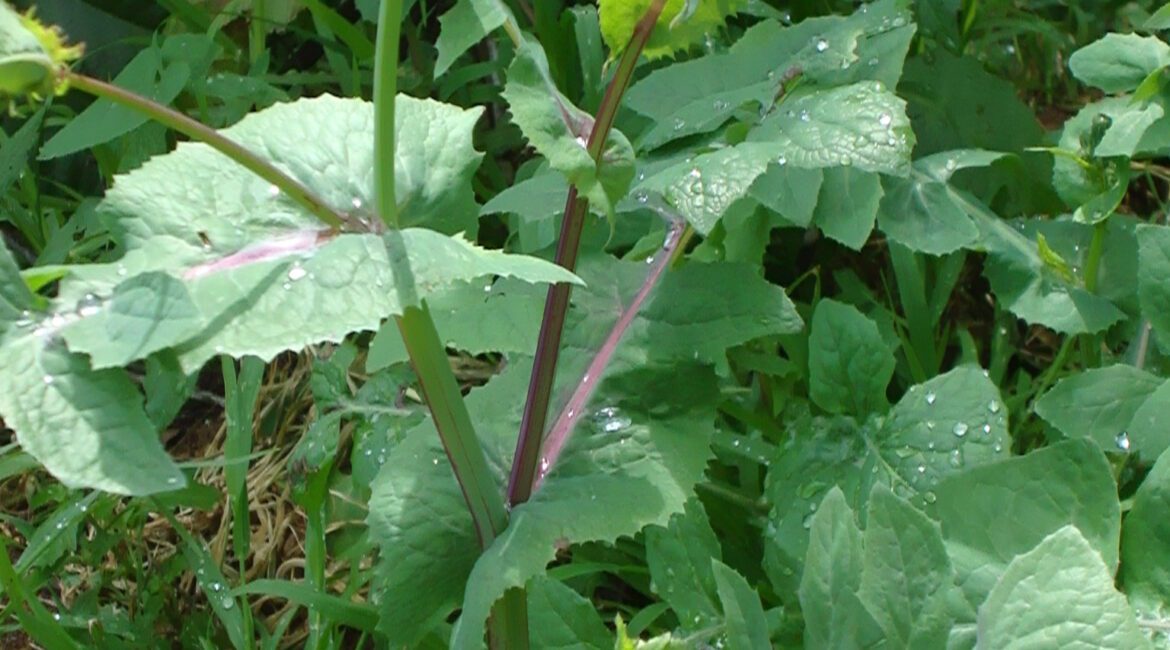SOW THISTLE (Sonchus oleraceus and other species)
Sunflower Family (Asteraceae)

DESCRIPTION:
Sow thistle is commonly mistaken for dandelion, to which it is related. Sow thistle is an annual weed with a more or less erect stem that rises from one foot to four feet tall.
The young plant forms a rosette of large pinnately divided leaves, which are characterized by their almost triangular terminal lobe. The young sow thistle is distinguished from dandelion by its tender bluish-green leaves. The lower leaves on the mature plant are glaucous and pinnately divided. The upper leaves of the mature plant are more or less entire, and they clasp the stem. When a leaf is torn or the stem is cut, a white sap oozes out.
The yellow flower heads are clustered at the top of the plant. The flower heads closely resemble dandelion flowers except that the base of each sow thistle flower is somewhat swollen. Each flower head of sow thistle, like dandelion, is made up entirely of ray flowers.
| Sow Thistle | Dandelion | |
| Leaves | Leaves basal and on the stalk | All leaves are basal |
| Flowers | Multiple flowers per stalk | One flower per stalk |
| Flower stalks | Branched, leaves on stalks | Leafless flower stalk |
| Edibility | Leaves and stalks edible raw, or cooked. Root edible cooked. Flower buds can be pickled or cooked. | Leaves best cooked because of bitterness. Root edible cooked. Flower buds can be pickled or cooked. |
Sow thistle can be easily distinguished from dandelion since dandelion flowers appear singly on each flower stalk, whereas sow thistle flowers appear in groups on the stalk. Also, unlike sow thistle, dandelion flower stalks are leafless. The flowers of sow thistle mature into cottony heads which facilitate the seed’s dispersal by the wind.
WHERE FOUND:
This European native has now naturalized throughout much of the world. It is found mostly in the urban environment, in virtually all gardens, vacant lots, untended lawns, parks, and even in sidewalk cracks. In wilderness areas, it is found mainly along the streams in sandy soil and occasionally in moist fields and meadows.

USES:
Raw sow thistle leaves are only slightly bitter, and with a crisp texture, they are great used in salads, either alone or mixed with other greens. The young cooked leaves make a mild dish similar to spinach popularly enjoyed the world over. Pinch off just the leaves for cooking, preferably the large lower ones. The upper leaves are also acceptable but tend to have a bit of bitterness and may require longer boiling, depending on your taste.
The stout stems of the just-beginning-to-flower plant are tasty eaten raw. They need to be first peeled of their thin (and slightly bitter) outer layer, which is usually tinged with red. These stems are good in salads and can be steamed or added to soups.
The tender fresh leaves can also be used in soups, stir-fries, and omelettes. The leaves are mild and very versatile. Even your “finicky” guests will enjoy it.
The root – while still young and tender – can be boiled and eaten, somewhat like a parsnip.
The roots can also be used for a coffee substitute like the dandelion root, although the result is inferior to dandelion root coffee. The roots need to be dug, washed, dried, and then roasted dark brown. Then they are ground and percolated into your coffee.
PROCESSING:
Pick the fresh leaves, rinse, dice or mince, and add to salads or soups.
The root requires a bit more work to scrub off the dirt, but can otherwise simply be boiled, or dried and made into a coffee substitute.
WHEN TO HARVEST/ AVAILABILITY:
Sow thistle is an annual. The leaves and roots are best gathered in the spring before the plant has flowered.
MEDICINE/NUTRITION:
According to the USDA, 100 grams of sow thistle raw leaf contains 33 calories, 2.2 grams of protein, 131 mg. of calcium, 60 mg. of phosphorus, 2.85 mg. of iron, 144 mg. of sodium, 481 mg. potassium, 2,185 I.U. of Vitamin A, 23.9 mg. of Vitamin C, 59.2 grams of Omega 3 fatty acids, and trace amounts of beta carotene.

RECIPES:
SOW THISTLE DELUXE
2 Cups sow thistle greens, diced
1 Cup cooked rice
½ onion, diced.
¼ Cup chopped walnuts
Butter
Boil the sow thistle with the onion. When done, strain the water. Blend in the cooked rice. Top with chopped walnuts and butter. Serves 2.
SOW THISTLE CAMPER
2 C. of sow thistle greens and tender stems, chopped
½ onion
Butter, to taste.
Sautee the onions til tender. Add the sow thistle and cook for two minutes. Add butter and serve.
HALCON ASPARAGUS
A dozen tender sow thistle stems, leaves removed
Butter or cheese.
Boil the stems for a minute, and strain. Top with butter or cheese and serve.

About the Author:
Nyerges has been teaching ethnobotany since 1974. He is the author of “Guide to Wild Foods and Useful Plants,” “Foraging Wild Edible Plants of North America,” and other books on the uses of wild plants. He can be reached at www.SchoolofSelf-Reliance.com.



